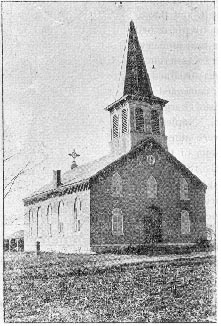From "Manual of the Churches of Seneca County with Sketches of Their Pastors, 1895-6," compiled and published by the Courier Printing Company, Seneca Falls, N. Y. 1896, pp. 98-100. Book available online here. (Offsite)

Central Pennsylvania Conference, Williamsport, Pa., district, Seneca station, Seneca county, N.Y., locally known as "The Burgh" church, was organized in 1816, by the Rev. Jacob KLEMFELTER. It was then called the Lake mission, Canaan district, Rev. John DREISBECH, presiding elder. The plan adopted was preaching from house to house and holding camp meetings. Many were converted and added to the church. The following are the pastors who served the society the first eighteen years: Rev. Jacob KLEMFELTER, 1816; John STILLING, 1817; Fred KALTRIETER, 1818; John KLEMFELTER, 1819; Samuel MUCK, 1820; M. Walter, 1821; J. DEHOFF, 1822; F. W. GLASSER, 1823, 1824; Christian WOOLF, 1825; J. ERLY, 1826; G. REICH, 1827; Philip WAGNER, 1828; G. REICH, 1829; F. GLASSER, 1830; G. SCHNEIDER, 1831; J. S. HIMMELREICK, 1832; D. KEHR, 1833; J. HARLACHER, 1834.
During this period of eighteen years, the work of the Lord had prospered and the numbers had increased so fast that it was deemed advisable to build a house suitable for the worship of God, and, under the leadership of Rev. Phillip WAGNER, presiding elder, and Rev. M. F. MAZE, pastor in charge, the work was begun, the money raised, and the building completed and dedicated in 1835. The following trustees were appointed to take charge of the church property: Jacob REIGEL, Henry MANGER, Jacob BACHMAN, John HOSTER and Samuel PONTIOUS. The land upon which the building and sheds stand was donated by Jacob REIGEL. The society was legally incorporated May 4,1846. During the first forty years the preaching was entirely in German. In 1837, under the preaching of Rev. WAGNER, a powerful revival took place, resulting in a large addition to the membership. Some time in the Sixties, the church building was twice struck by lightning and considerably damaged, but it was again repaired. In 1871, under the leadership of Rev. L. HORNBERGER a new roof was put on.
In 1874, the Rev. R. J. SMITH was sent to the charge; the church and parsonage were in a very bad condition and the pastor was so disheartened at the outlook that he was tempted to decline the place, but changed his mind and went to work. He urged upon the people the need of building a suitable house in which to worship God, and, at the first quarterly conference, the following ladies were appointed to solicit subscriptions to accomplish the work: Miss Debbie HOSTER, Miss Sadie PONTIOUS, Mrs. H. RIEGEL, Mrs. W. SHERRIDAN, Mrs. M. SHERRIDAN. A building committee consisting of Henry HOSTER, John RITTER and Jacob BACHMAN, was also appointed, with R. J. DERRICK, treasurer, and George HOSTER, secretary. The repairs commenced September 1, 1874, and the church was dedicated February 7, 1875, by Rev. S. F. BUCK, one thousand dollars being raised on that day, to pay the balance of indebtedness. In March, 1877, Rev. U. F. SWENGEL was appointed by the conference, to this pastorate. In November and December, 1878, a very interesting protracted meeting took place and forty-seven presented themselves at the altar. In March, 1880, E. SWENGEL, a brother of the preceding, was appointed as pastor and served four years. Rev. A. STAPLETON was appointed in the spring of 1884. Rev. J. HORNBERGER was appointed, March, 1885, and served two years. Rev. M. J. SNYDER served from March, 1887, to March, 1889. The conference of 1889 did not send any pastor, but Rev. G. HUNTER preached several Sabbaths, and in June of the same year, H. B. BARSHINGER, at the solicitation of the presiding elder, assumed charge; but at the close of the conference year the church was in a sad condition, both spiritually and financially. Since that time it has had no regular pastor, but has had occasional preaching services, Rev. A. N. DEPEW, a retired clergyman of the Methodist Episcopal church being the last to fill the pulpit. The church and parsonage buildings are now wholly out of repair, and we will not make any prophecies for the future, but leave our case with the Lord.
It has been said lightning will not strike twice in the same place, but the photo-engraving of the church, herewith produced, shows the damage caused by the third lightning bolt upon the same steeple.
The Evangelical Association, to which the Bergh church belongs, though never very strong in New York State, has a large membership in Pennsylvania and some parts of the West. This denomination owes its origin to the "strict construction" which Bishop ASBURY of the M. E. church placed upon the plan of itinerancy.
About 1790, Jacob ALBRECHT, or as he is better known, ALBRIGHT, a "Dutch" Methodist Itinerant, urged the bishop to organize a presiding elder district of German speaking preachers and people. Bishop ASBURY, however, felt that the itinerant plan required that every preacher should be eligible to every charge, and so refused. ALBRIGHT, then, with no ill feeling but from a firm conviction of duty, originated his church of German speaking Methodists, with doctrines and discipline the same as the Methodist Episcopal at that time. The denomination was long popularly known as the "Dutch Methodists." The wisdom of ALBRIGHT's suggestions to Bishop ASBURY, has since been justified by the organization of German conferences in the Methodist Episcopal church.